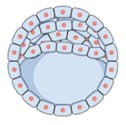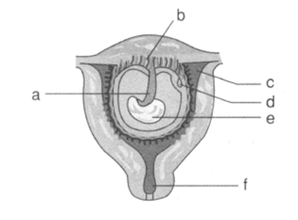Implantation
Implantation: Overview
This topic covers concepts, such as Cleavage of Zygote, Morula, Blastocyst, and Implantation.
Important Questions on Implantation
Assertion: Holoblastic cleavage with almost equal sized blastomeres is a characteristic of placental animals.
Reason: Eggs of most mammals, including humans, are of centrolecithal type.
How many germinal layers does embryo consist of initially, after implantation?
Match the following and choose the correct options:
| A. | Trophoblast | i. | Embedding of blastocyst in the endometrium |
| B. | Cleavage | ii. | Group of cells that would differentiate as embryo |
| C. | Inner cell mass | iii. | Outer layer of blastocyst attached to the endometrium |
| D. | Implantation | iv. | Mitotic division of zygote |
Match the items given in Column I with those in column II and select the correct option given below.
| Column I | Column II |
| (A) Trophoblast | (i) Embedding of the blastocyst in the endometrium |
| (B) Cleavage | (ii) Group of cells that would differentiate as an embryo |
| (C) Inner cell mass | (iii) The outer layer of blastocyst attached to the endometrium |
| (D) Implantation | (iv) Mitotic division of the zygote |
Right and left sides of an embryo become apparent during ___________.
Which layer of blastocyst projects into the endometrium and destroys endometrial cells?
cleavage takes place about hours after fertilization.
Cleavage converts zygote into a mass of cells called
Which type of division occurs in cleavage?
How many cells are present in morula stage.
Fill the blanks in the given statements and select the correct option.
A. The developmental stage of an animal passed in the mother's womb is called (i)
B. The outer layer of blastula is called (ii) . It does not take part in the formation of (iii)
C. (iv) is the first germ layer formed from the inner cell mass by differentiation.
Given below are four statements each with one or two blanks. Select the option which correctly fills up the blanks in any two statements.
(A) The embryo with 8 to 16 blastomeres is called (i).
(B) Embedding of the (i) in the endometrium of the uterus is called implantation and it leads to (ii).
(C) After implantation, finger-like projections appear on the trophoblast called (i), which are surrounded by the (ii) and maternal blood.
(D) Inner cell mass contains certain cells called (i) cells which have the potency to give rise to all the tissues and organs.
Identify the human developmental stage shown as well as the related right place of its occurrence in a normal pregnant woman and select the right option for the two, together.

Implantation takes place after _________ of fertilization.
Match column I with column II and select the correct option from the codes given below.
| Column I | Column II |
| A. Cleavage | (i) Fertilisation |
| B. Morula | (ii) Mitotic division |
| C. Polyspermy | (iii) Endometrium |
| D. Implantation | (iv) Little mulberry |

